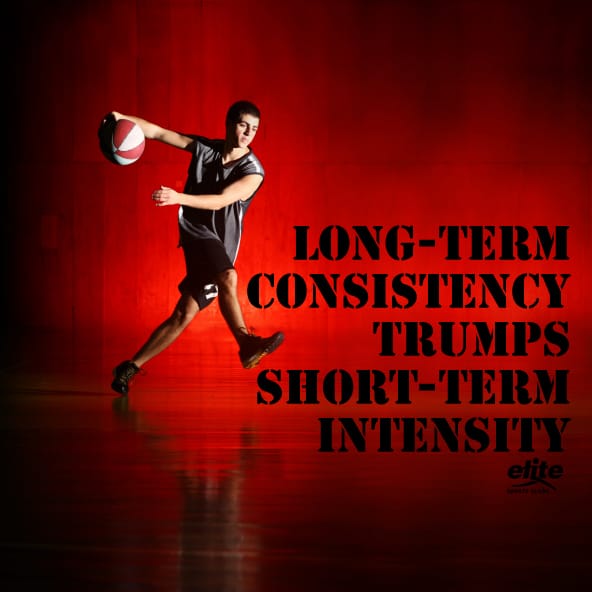
One of the most common questions we get is “can you get my son/daughter in shape for X sport in 5 or 6 weeks?” The answer is yes, we can get to see some small improvements in 5 or 6 weeks because the child has not been overly active as of recent or are coming out of a different sport season and they were not working out. But to truly see the best results consistency will always win out. As Bruce Lee once said, “long-term consistency trumps short-term intensity.”
The benefits of getting into a long-term training program are plentiful, and encompass not only physical health, but also serve as important life lessons.
Life Lesson 1: Time Management
One of the life lessons of setting up a consistent training program is it teaches the athlete the value of time management. Most kids have hectic schedules between school, practice/games, texting, family, sleep, Angry Birds/Pokémon, homework, social life, etc. So being able to make the opportunity of improvement a priority can help them see that there is in fact time in the day, but it must be made a scheduled priority. This is a life lesson they can take forward as they move on in school and life. If the athlete is fortunate enough to go on and compete at higher levels training is going to be a structured part of the day so it’s best to start and lay the foundation early.
Life Lesson 2: Teamwork
Besides time management another life lesson benefit is learning to be part of a team. This can be demonstrated in a couple of different ways. One way, is to be a supportive teammate. Maybe one day in the workout one of your training partners is just running a little low on energy, you can be there to help pick the kid up with encouraging words or a little cheering. Another way learning to be part of a team is to help the coaches with form corrections. We have all had days when we are working out and our form gets a little questionable, but if the athlete is cognizant of it they can help the other athletes perform the exercises safely.
Health Benefit 1: Establishing a Workout Routine
The first health benefit is that trying to gain incredible improvements in 5-6 weeks can lead to some very aggressive training sessions really stressing the body’s ability to recover which can lead to some negative consequences. Many professional athletes begin training for their sports about 6-10 weeks out depending upon schedules, but it is the work that they did for the days, weeks, months, and years leading up to that time that allow that to happen. Not too mention, those 6-10 weeks are filled with two-a-day workouts for 5-6 days a week. No school, job, tests, etc. That is their job. Plus, they will often have a team of nutritionists, therapists, cooks, etc. helping with all the things that help them recover and be able to perform those strenuous schedules.
Consistency will help lay the foundation for a healthier lifestyle later in life. By establishing a routine of working out and taking care of their bodies for sport, these lessons can also taken forward in life and used in college and adult life. Many athletes have mentioned how they can feel changes in their bodies happening as they begin working out and eating properly, this is a good feeling they can continue to tap into later in life.
Health Benefit 2: Better Results
Consistency also leads to better results. The more consistent the program and dedication to it the athlete is, the longer lasting any improvements that are made will last. Often times athletes will begin to work out and notice that they are in fact getting stronger but then for a plethora of reasons may take a break from training and when they come back they find themselves starting back from square one. However, the higher the training age of the athlete the longer their strength, mobility, power, etc. Stay with it. When athletes take short breaks they either start where they left off or much closer than that if they have not made training a priority. Consistency does not always have to mean long grueling sessions. Many times athletes drop off from training during their competitive seasons, but even then a couple of 1⁄2 hour training sessions can help maintain strength, power, mobility, etc.
Along those lines repeated bouts of intense training progressed properly can help the athlete build stronger connective tissue as well as stronger bones. The principle of progressive overload tells us that the body will begin to adapt and become better at tasks that it is repetitively asked to do. Stronger connective tissue can help reduce the incidence of certain non-contact injuries seen in many athletes (ACL’s in female athletes or elbows in tennis/base or softball).
To learn more about how long-term training could benefit your young athlete, check out our Athletic Movement & Performance Program.
By Jason Liegl, Certified Personal Trainer and AMP Program Coordinator at Elite Sports Club-Mequon
